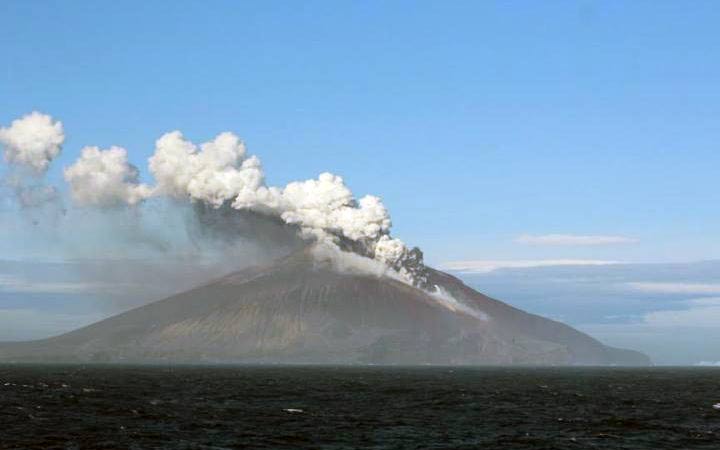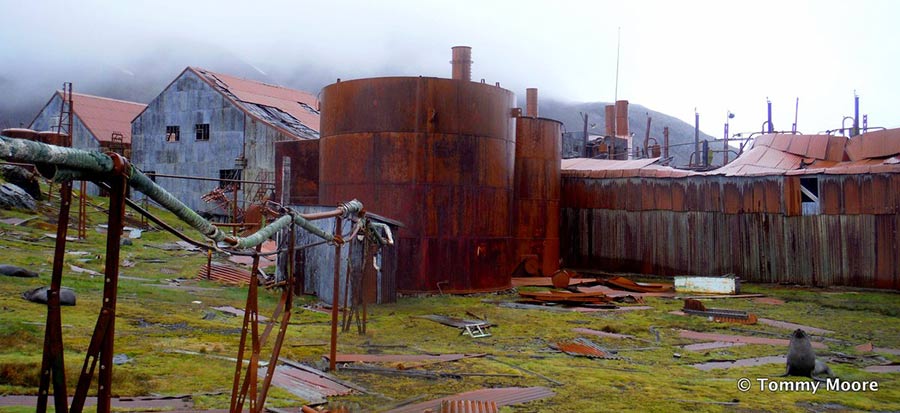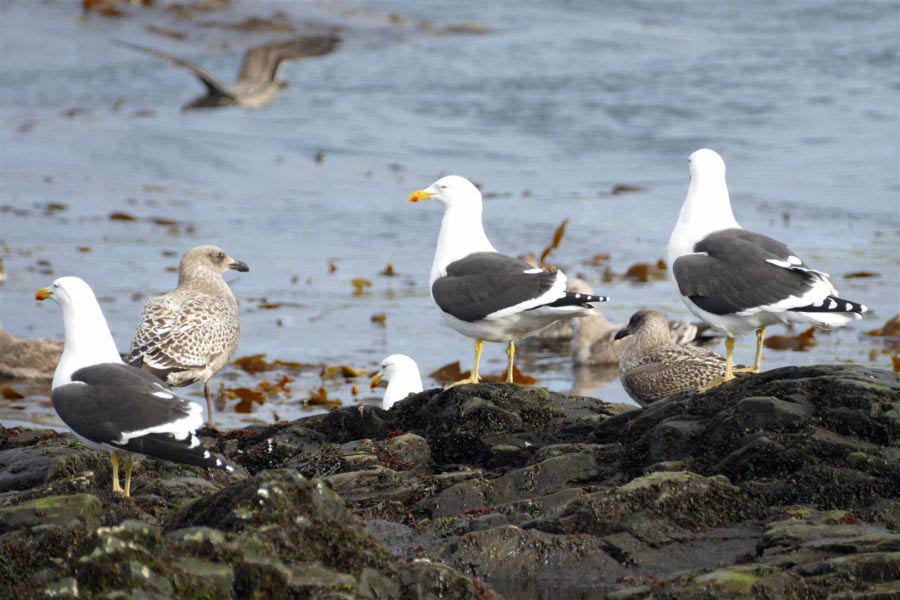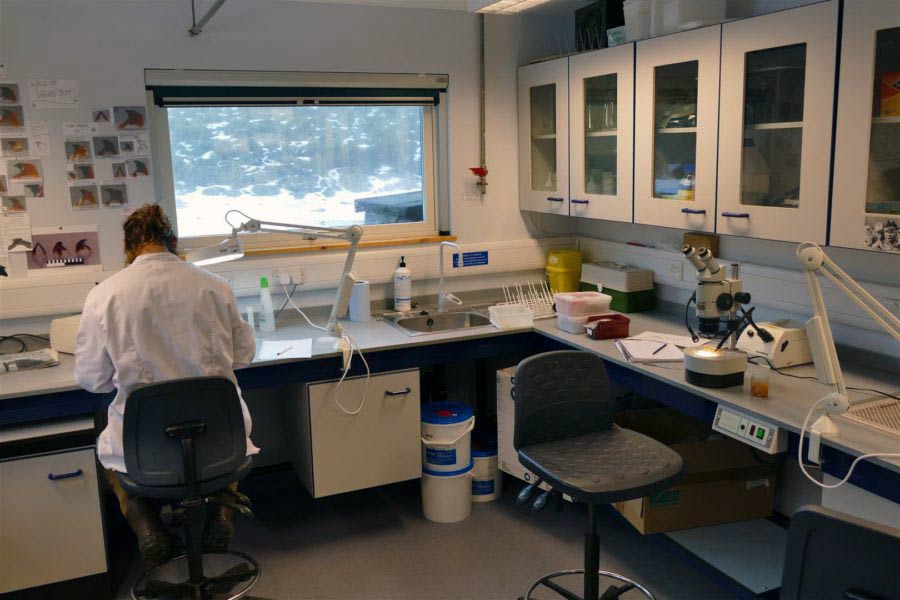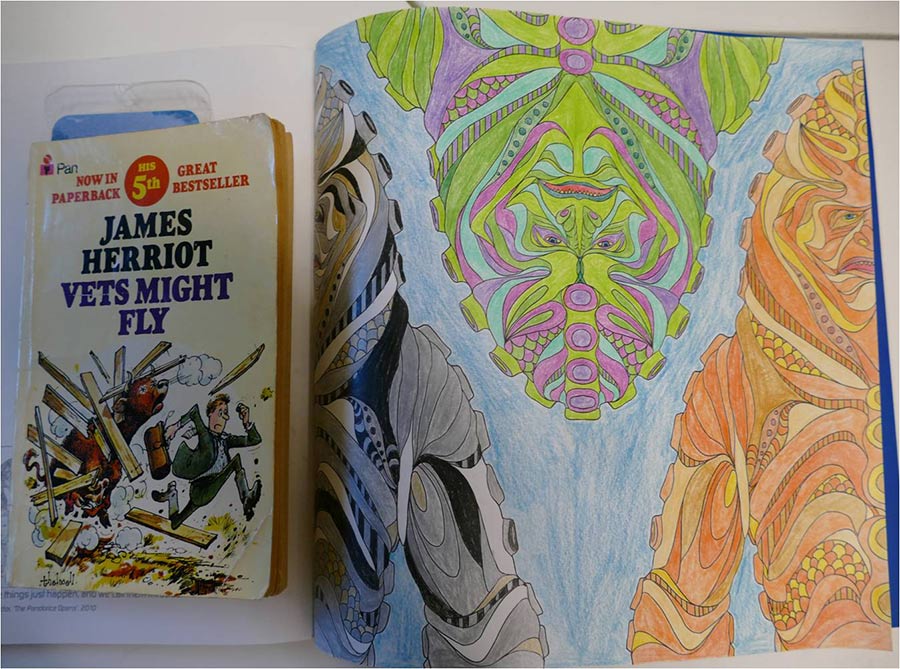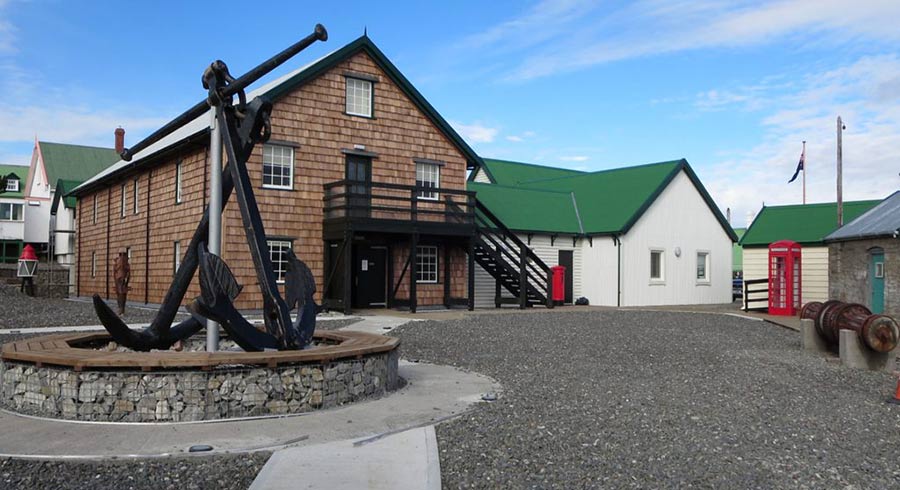This newsletter is not produced by GSGSSI; it does not necessarily reflect their views.
To subscribe to the SGIsland News Alerts list click here
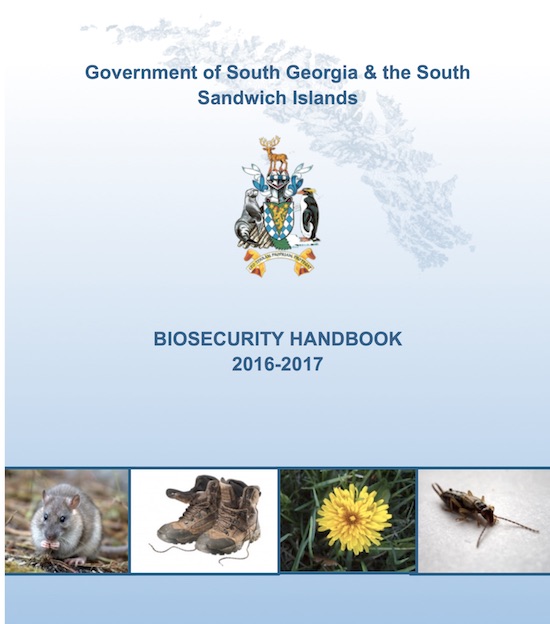 Ensuring that effective, comprehensive biosecurity measures are in place is vital to protect the native flora and fauna of the Territory and is a key strategy commitment for the Government of South Georgia & the South Sandwich Islands (GSGSSI). Current biosecurity policy is set out within GSGSSI’s Biosecurity Handbook.
Ensuring that effective, comprehensive biosecurity measures are in place is vital to protect the native flora and fauna of the Territory and is a key strategy commitment for the Government of South Georgia & the South Sandwich Islands (GSGSSI). Current biosecurity policy is set out within GSGSSI’s Biosecurity Handbook.
To make sure our policies are up to date, and reflect best practice, GSGSSI undertakes an annual review of biosecurity operations to check the efficacy of our policy, identify any emerging threats and take action to mitigate risk including the development of new and improved control measures.
Between June 2015 and May 2016, 257 biosecurity checks on cargo and baggage were undertaken by Government staff at King Edward Point and at the gateway port of Stanley, Falkland Islands. Of the 885 items that were individually inspected during these checks, biosecurity infringements were detected on 60. Infringements ranged from incorrect packing protocols that could leave boxes vulnerable to rodent or invertebrate infestation to collection of dirt and seeds from cargo items, vehicles and clothing.
Particular focus is given to preventing the introduction of rodents to the Territory. All vessels are required to carry bait stations and declare findings to Government Officers. In total 138 bait stations were deployed on vessels including fishing vessels, cruise ships, yachts, Royal Navy and Government vessels. 117 rodent monitoring stations were deployed on shore. No signs of rodents were reported either on land or at sea.
Based on the findings of the review of biosecurity operations the following principal changes in policy have been instigated for the 2016/2017 season:
- Additional cleaning protocols and checklist for transport of vehicles.
- New packing guidelines for cargo moving between King Edward Point and Bird Island.
- Following a successful trail in the 2015/16 season, the utilisation of rodent proof cargo packing boxes on all routine GSGSSI cargo operations on Pharos SG.
- Revised guidelines for placement of rodent and invertebrate monitoring devices in shipping containers.
- Additional rodent biosecurity inspections for yachts.
The 2016/2017 Biosecurity Handbook can be downloaded here.
As part of an on-going process to develop new and improved control measures in collaboration with key stake-holders, GSGSSI is investigating options for enhanced screening for rodents on vessels and at gateway ports in the Falkland Islands. They are also working with the British Antarctic Survey to develop improved cargo handling and biosecurity facilities at both King Edward Point and Bird Island. It is hoped that they will be introduced these in future editions of the Biosecurity Handbook.
Volcanic eruptions have been reported on Zavodovski Island (Mt Curry) and Bristol Island (Mt Sourabaya) within the South Sandwich Islands chain.
Eruptions are emitting significant ash and dust deposits.
No landings will be permitted on the islands until further notice. Mariners are advised to remain clear of the islands by at least 3nm and, where possible, remain upwind of any ash or dust deposits.
The Government of South Georgia & the South Sandwich Islands (GSGSSI) is pleased to announce that the South Georgia Icefish Pelagic Trawl Fishery has been re-certified by the Marine Stewardship Council (MSC) for a further 5 year period. The fishery has been assessed against the MSC’s Principles and Criteria for Sustainable Fishing and has been certified ‘condition free’, meaning that the management and operation of the fishery meets all MSC sustainability requirements to a high standard. The re-certification is valid for 5 years from 5 July 2016. The determination was carried out by Acoura Marine on behalf of the industry (Polar Ltd), and supported by GSGSSI, and is a further demonstration of collaborative commitment to the highest standards of fisheries operation, stewardship and sustainability at South Georgia.
In June GSGSSI launched its consultation on a comprehensive review of the medical facilities and expertise available on tourist vessels visiting South Georgia & the South Sandwich Islands. The review makes recommendations for a set of minimum standards for operators to follow.
The comprehensive review was commissioned following a fatal accident involving a cruise ship passenger on South Georgia in 2012. Following the delivery of a Narrative Verdict, HM Coroner wrote to the vessel operator involved in the incident, IAATO and the Government of South Georgia & the South Sandwich Islands with a number of recommendations. Those directed to GSGSSI related to the management of extended walks and the provision of medical treatment and care of tourists on visiting vessels (including yachts).
SGSSI Medical Review cover letter to stakeholders [.pdf, 0.3mb]
SGSSI Draft Medical Review & Recommendations [.pdf, 0.3mb]
World Extreme Medicine is now considering responses to the consultation with a view to finalising their review.
1. South Georgia Non-Native Plant Management
The Government of South Georgia & the South Sandwich Islands is pleased to invite tenders for the provision of labour and management oversight for the delivery of the South Georgia Non-Native Plant Management Strategy 2016-2020. Proposals must be submitted no later than 12 noon GMT, 5 August 2016.
Full details here.
2. Scoping Project for Remediation of Oil Waste on South Georgia
The Government of South Georgia & the South Sandwich Islands is pleased to invite tenders for a project which aims to provide clear and costed recommendations to GSGSSI for the remediation of waste fuel oil in the former whaling stations on South Georgia at Grytviken, Husvik, Stromness, Leith and Prince Olav Harbour. This will require undertaking a survey to assess the quantity and current state of the residual oil in the whaling stations. In addition you may wish to include within your tender the assessment of the oil pollution risk posed by sunken whale catcher vessels in the vicinity of Leith harbour. Proposals must be submitted no later than 12noon GMT, 31 August 2016.
Full details here.
A Government Officer is being recruited who will act as the Government’s official representative on South Georgia and discharge the Government’s responsibilities. The role is available on a 3-year contract.
The job description and application form can be found here.
The closing date for applications is 19th August 2016.
By Katherine Ross
Ann was the post mistress for South Georgia between 2003 and 2005. She was clever: a fierce environmentalist, an awesome cook, and a good friend.
The Ann I knew said yes to everything that sounded fun and gave whole-heartedly wherever she went. She died on the 27th of April 2016 in Scotland and was remembered in Shetland, Orkney, Fair Isle and the Falklands, all places that she loved, and was loved. All places she enjoyed terrific seas, many cup of teas, occasional tots, walks, walks, walks, birds, birds, birds, and some damn good swearing!
In South Georgia she indulged our young team’s youthful idealism with warmth and sparky enthusiasm. And she fed us well. Ahead of her time, and never afraid of hard work, Ann pioneered early attempts to remove bittercress by hand: pulling up plants and filling huge aggregate bags with contaminated topsoil. Previously, when living on a narrowboat (which sank, thankfully her cat survived!), Ann learned to decorate hardware with a traditional jolly flourish. In South Georgia she painted a big, bright sign for the Post Office and was proud when it appeared on stamps celebrating the centenary of that out-post.
Ann was a careful observer, she loved nature and was knowledgeable about wildlife (and the habits of wildlife watchers!). I loved her stories of surveying shy red throated divers in Shetland, of bonxies in Fair Isle and of being utterly lost in tall Falklands tussac while searching for boisterous Johnny rooks.
Did I mention Ann’s cooking? Ann often worked as a cook (a writing, painting, singing cook) and was brilliant at it. Her food was made with love and brought people together: Ann’s cheesy-oaty-scones are famous across the world. She hated waste and once served up road-kill for a group of artists in Aberdeenshire; she also used a very broken camera to take photographs for her friendly food column in Shetland Life, somehow she managed to serve decent photos with no functioning view finder! BAS folk laugh to recall the time she made delicious chutney from several year’s supply of dried onions. We all yummed it up in our smoke rolls.
The thought of Ann’s sparkling smile makes me grin whenever I prepare to cook something fun; what a lovely legacy for an extraordinary woman.
By Tim Morley, Zoological Field Assistant at Bird Island, British Antarctic Survey
With many of our species finishing breeding for the summer season winter has truly hit Bird Island, and the freezing temperatures and thick snow certainly emphasize the season we are now in! But although we have concluded monitoring for many species there is still plenty of work to be getting on with and even more fun to have; here is what happens in a typical week for winter on BI.
Monday
On Monday I completed the geep bird work for the year by typing the final results into our databases. Whilst there was still one chick left at this point I could upload all the data and just adjust for the final chick when it does fledge. Our online databases link directly back to BAS Cambridge where our managers can review the years’ data.
Of course it’s difficult to stay inside all day, even when we are firmly in the grip of winter, as there is so much wildlife still around. So I spent a short time in the afternoon just out in front of base with some kelp gulls and Antarctic terns feeding amongst the kelp.
Tuesday
In just a few weeks time we will be celebrating midwinter. This is a big celebration each year, partly because we are generally too busy around Christmas to get the full holiday spirit going (although Christmas was a lot of fun!) and partly because there are a few events that bring all bases on the continent together at this time. To start celebrations we have our annual “Secret Santa” type arrangement where we all make a gift for someone else on station to open at midwinter. This is a great reason to fully utilise our workshop and get busy with some woodcraft!
After putting some final touches to my midwinter gift it was time to get in to the lab and begin some identification work. The krill, squid beaks and otoliths (fish ear bones) collected from macaroni penguin and geep diet samples through the summer now have to be measured to identify sex, life stage (krill only) and species (squid and fish). By doing a few hours a day a few days a week the lab work is completed in plenty of time for the final season reports (in August) without us getting stuck in there for too long at any one time – staring through a microscope at tiny bones gets a bit draining!
Wednesday
The wandering albatross raise their chicks all through winter and as such we are never fully deserted of wildlife to monitor. The first of each month, until September, marks an all island wanal census where we go out and check that each nest is still active, recording those that have failed in the preceding month. The chicks are now getting noticeably bigger and filling up their nests very nicely!
I covered an area on the east side of BI with the furthest wanal chick being all the way on the point of Farewell Point, the eastern extreme of the island. This is an area we get to rarely as there is little survey work on this part of the island, so it is always amazing to be able to get out and see a different location occasionally.
During the census Ian actually confirmed the final geep chick to have now fledged! Goodbye chicks, good luck! Now it is a case of waiting until September for the breeding season to start anew.
Thursday
Now that there are just four people on base the cooking rotation comes around quicker than before. Thursday was my shift this week and whilst we are obviously lacking in the fresh food department we are certainly not restricted when it comes to frozen or dried foods.
The cooking rota can sometimes be a bit of a pain, but that is when simple meals like baked potatoes and pasta pesto come in handy. Other times it is a great opportunity to experiment and try something different as during winter we generally have a bit more time to prepare. The quality of food served on BI has been very high and much more varied than I expected to be possible before coming south.
During summer every meal was eaten at the table. But during winter we have weekend meals at the table but during the week we switch to TV dinners, often followed up by a bit of Mario Kart on the Wii.
Friday
Friday is our scrubout day. The station is divided into sections; boot room and toilets, kitchen and foodstores, living room and offices, lab and waste management. We rotate through these jobs each taking a different area each Friday and giving it a good clean. The station is well kept and these regular scrubbings makes sure it stays that way.
Besides all the work done during the week and the ways we relax in the evening there are times during winter when it is quiet enough to have a bit of a slow afternoon. When this happens it can be filled with any amount of hobbies. There are puzzles and craft books on base, a whole bookcase full of novels to read, the workshop is always available for projects to be done and of course there is whatever we brought down ourselves to keep us entertained. So I spent Friday afternoon reading James Herriot and colouring in some Zygons! Not a bad way to relax!
Saturday
Saturday is a day we always make sure to put a bit extra effort in to doing something as a group. This is particularly helpful during the summer when we are all so busy with fieldwork that we may not spend that much time with other people. But the tradition continues through winter with Saturday being a three-course meal and can be a themed night (although not always).
We usually follow up the meal with a game of some sort, sometimes this is cards or a board game, other times it can be a pub quiz, dance night or some other game we have designed and built for the station. From cornchucking to murder mystery, lightsaber battles to monopoly, stargazing to rummy we have done quite a few different things over the previous weeks and months; and this week James was on Saturday cook and set up a great meal and some fun card games.
Sunday
Once a fortnight there is another survey to keep me outside with the wildlife, the pintail and sheathbill count. This is conducted along a stretch of coastline either side of base and usually takes about two hours, walking along the cost and counting every sheathbill and pintail along the way.
This gives us an indication of wintering populations for comparison to work ongoing at King Edward Point and the work they are doing there after the rat eradication project (Bird Island was already rat free and so can be a control location).
When it has been snowing quite a lot then the tussock grass gets hidden under a blanket of white. This makes it a lot of fun walking around between places, crunching in the snow or sliding down slopes. Of course we are always in danger of not seeing a gap below the snow and falling through the tussock!
The pintail route along the coast is the same as the leopard seal route, so whilst counting ducks and sheathbills we also keep an eye out for leps. These guys are absolutely massive, the largest getting up to 3.5 metres (males) to 4 metres (females) long! It is great seeing such a well developed predator up close.
After work it is always nice to relax and every Wednesday and Sunday are film nights. We are lucky enough to have a projector hooked up to our TV on station and so have our own mini-cinema for these occasions. Whoever is on cook gets the film choice that day so everyone gets a fair share of picking the film, this week it was Ian’s choice and we watched The World’s Fastest Indian which is a great film!
A major centenary exhibition from the Scott Polar Research Institute: By Endurance We Conquer: Shackleton and his Men opened at the start of June at the Historic Dockyard Museum, Stanley, to commemorate the Imperial Trans-Antarctic Expedition of 1914-17 which set out to cross Antarctica via the South Pole. It tells the story of the loss of the Endurance, the marooning that followed and the epic journey to find rescue.
The exhibition covered the time spent at Stanley by members of the expedition and includes Shackleton items loaned from the South Georgia Museum as well as a wooden scale model of the James Caird made for the Falklands Museum by polar explorer Seb Coulthard.
Additionally, the Government of South Georgia & the South Sandwich Islands loaned its multimedia interactive whaling station display to the museum until October. This display, which opened to visitors in South Georgia last season, allows the visitor to virtually explore South Georgia’s former whaling stations. The display used groundbreaking new laser survey technology, commissioned by the Government of South Georgia & the South Sandwich Islands and Norwegian Government, to digitally record this unique heritage. The exhibit included archive images from the stations and film interviews of the men who worked in them.
Also at the museum was the South Georgia Museum’s display on African Labourers on South Georgia, produced by Commander Chr. Christensen’s Whaling Museum, telling a hitherto largely unknown story about South Georgia’s whaling past.
The Falklands Museum will also be running a programme of related activities and presentations over the course of the southern winter.
- 19 – 20 September 2016: The Historical Antarctic Sealing Industry Conference 2016
http://www.spri.cam.ac.uk/events/thasic/
- 22 September 2015 – 3 September 2016: By Endurance We Conquer: Shackleton and his Men:
http://www.spri.cam.ac.uk/events/
Punta Arenas opens “Shackleton, 100 years” exhibition to honor the great explorer and Piloto Pardo
http://en.mercopress.com/2016/07/08/punta-arenas-opens-shackleton-100-years-exhibition-to-honor-the-great-explorer-and-piloto-pardo
James Robbins Blog: Midwinter on Bird Island
http://naturesfreedom.blogspot.co.uk/2016/06/midwinter-on-bird-island.html
South Sandwich Islands Volcanic Eruption:
http://www.livescience.com/55328-volcano-eruption-threatens-penguins.html
Dix Noonan Webb: Heroic Irishman’s Unique Medal from Shackleton Voyage to Be Auctioned
http://www.coinweek.com/auctions-news/dix-noonan-webb-heroic-irishmans-unique-medal-shackleton-voyage-auctioned/
Historical Photos Uncovered in Antarctic Ice
http://www.i4u.com/2016/07/113059/historic-photos-uncovered-antarctic-ice
Kinsale man’s medal for epic Antarctic journey set to make €24k at auction
http://www.irishexaminer.com/ireland/kinsale-mans-medal-for-epic-antarctic-journey-set-to-make-24k-at-auction-407465.html
Honour in success for Cork and Kerry’s South Pole explorers
http://www.irishexaminer.com/lifestyle/features/honour-in-success-for-cork-and-kerrys-south-pole-explorers-406627.html
Kildare illustrator captures epic Shackleton journey in new book
http://www.leinsterleader.ie/news/arts-culture-entertainment/209094/Kildare-illustrator-captures-epic-Shackleton-journey.html



